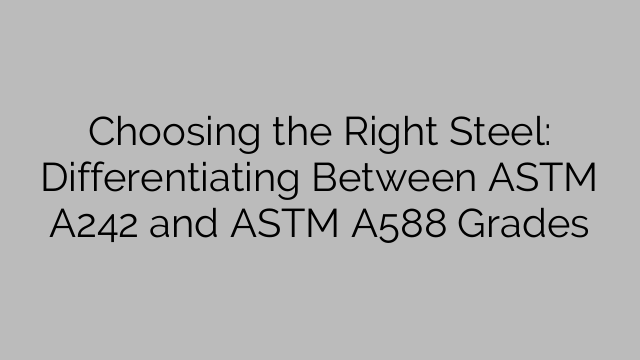Choosing the right steel for a specific application is crucial for ensuring strong and durable structures. Two widely used steel grades in construction are ASTM A242 and ASTM A588. While both these grades are classified as weathering steels, they have distinct differences that make them suitable for different applications. In this article, we will differentiate between ASTM A242 and ASTM A588 grades to help you make an informed decision when selecting steel for your project.
ASTM A242 and ASTM A588 are both high-strength low-alloy structural steels that provide excellent corrosion resistance. They are designed to form a protective oxide layer on the steel surface when exposed to the atmosphere, preventing further corrosion. This oxide layer, also known as a patina, not only protects the steel from environmental factors such as rain, snow, and humidity but also gives it a unique aesthetic appearance.
ASTM A242 steel grade, also known as weathering steel A or Corten A, is primarily used for the construction of bridges and buildings. Its corrosion resistance is obtained through an alloying process involving copper, chromium, nickel, and phosphorus. ASTM A242 is known for its high tensile strength, making it ideal for applications that require long-term structural integrity against harsh weather conditions.
On the other hand, ASTM A588 grade, also known as weathering steel B or Corten B, is commonly used in outdoor structures such as bridges, skyscrapers, and shipping containers. Compared to ASTM A242, ASTM A588 offers higher strength and improved corrosion resistance. This enhanced corrosion resistance is achieved through the addition of copper, chromium, and nickel, which create a protective barrier against atmospheric corrosion.
The key difference between ASTM A242 and ASTM A588 lies in their composition and mechanical properties. ASTM A242 has a minimum yield strength of 50 ksi (345 MPa) and a maximum tensile strength of 70 ksi (480 MPa). In comparison, ASTM A588 has a minimum yield strength of 50 ksi (345 MPa) and a minimum tensile strength of 70 ksi (485 MPa). Additionally, ASTM A242 has a maximum carbon content of 0.15%, while ASTM A588 allows for a slightly higher carbon content of 0.20% for improved weldability.
Another important factor to consider when choosing between these grades is the availability and cost. ASTM A242 is more commonly available in the market and is relatively less expensive compared to ASTM A588. However, the cost difference may vary depending on factors such as the size of the project and the location of the supplier.
In conclusion, ASTM A242 and ASTM A588 are both effective weathering steel grades with excellent corrosion resistance. Choosing the right grade depends on the specific requirements of the application. If higher strength and improved corrosion resistance are critical, ASTM A588 may be the preferred choice. However, if cost and availability are essential factors, ASTM A242 can still provide adequate performance for many construction projects. Consulting with a steel supplier or structural engineer can help determine the most suitable grade for your specific application, ensuring a successful and long-lasting construction project.

